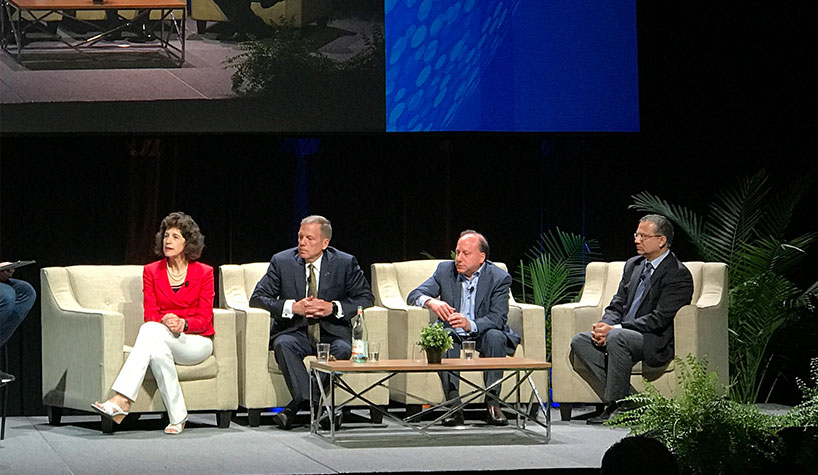Loyalty with hotel website found to be powerful driver of demand and growth. The Kalibri Labs study...
In the News
All About the Guest: How Technology is Transforming the Hotel Experience
BY ABBY ELYSSA
image-block-outer-wrapper
layout-caption-below
design-layout-inline
"
data-test="image-block-inline-outer-wrapper"
>
sqs-block-image-figure
intrinsic
"
style="max-width:818px;"
>
class="image-block-wrapper"
data-animation-role="image"
data-animation-override
>
>

Left to right: Cindy Estis Green of Kalibri Labs; Mark Carrier of B.F. Saul Company Hospitality Group; Barry Goldstein of Wyndham Hotels & Resorts; and Ash Kapur of Starwood Capital Group
HOUSTON—Technology is at a crossroads in the hospitality industry. While brands are trying to connect the dots and patch up areas of disconnect, they’re also trying to bring in new, advanced guest experiences. The challenge comes from integrating these innovations into legacy properties, which may have more outdated technology in place, making the shift costly. But one aspect that holds true across all properties is a strategy of consistency in experience, which was discussed at this year’s HITEC Houston.
During the “Technology and the power of the C-Suite” general session, a panel of top-level executives gave possible solutions to this challenge, as well as hopeful insights. While there was some opposition about how exactly to overcome technology’s transformations, all agreed that it could either make or break the guest experience, depending on its functionality—whether or not this technology works properly.
Ash Kapur, SVP of hotel asset management and CRO for Starwood Capital Group, stressed the importance of having a brand vision and a set strategy for long-term goals. “I see a lot of Band-Aids; I see a lot of things broken. What bothers me is that there is not a single approach today in technology,” he said. “The hospitality space is extremely myopic.”
Mark Carrier, president of B.F. Saul Company Hospitality Group, agreed, but recognized that while a disjointed strategy may obstruct a cohesive guest experience among properties, it presents new possibilities. “Rather than an integrated technology approach for brand companies, it ends up patched together. Not being fully integrated creates opportunity for innovative, faster moving companies,” he said.
Others weighed in, noting how guest experience plays into this strategy. Cindy Estis Green, CEO of Kalibri Labs, mentioned that it wasn’t always about guest-facing products. With technology being tactical in the early days, very little emphasis was put on the guest journey, but now, it’s taking center stage. “Now it’s part of the brand definition. You can build technology around exactly what you want the brand to deliver,” she said. “To do technology because it’s cool doesn’t make it. To do technology that actually becomes seamless in the guest experience is the magical part.”
A consistent brand strategy has to encompass functioning technology for a frictionless guest experience. According to Barry Goldstein, EVP and chief commercial officer for Wyndham Hotels & Resorts, hotels have very few chances to get this right. Goldstein said that once a hotel presents guests with a product that simply doesn’t work, the guest no longer wants to interact.




